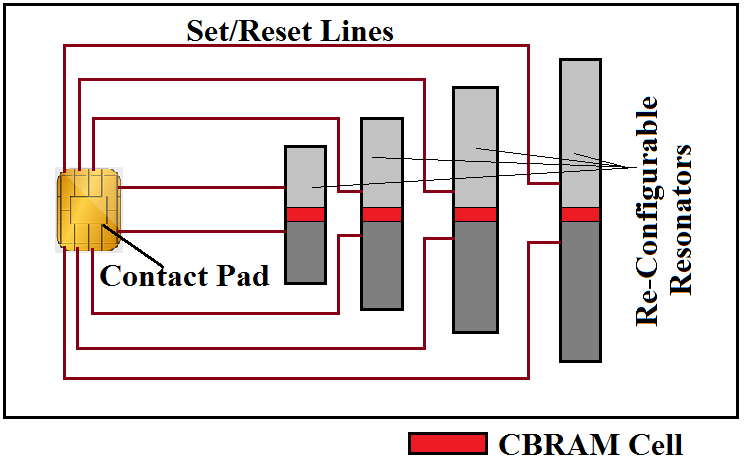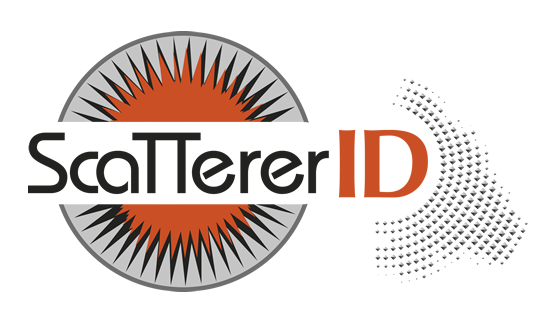CBRAM
A focus on Reconfigurable chipless and RF switches:
Low-power, passive and non-volatile RF switches are an area of keen interest among the scientists and industry in the current decade. Non-volatile switches would benefit every field of RF-engineering by drastically cutting down the power budget. With the current threshold of development in disposable printed RF electronics, the requirement for passive and low power switches has been intensified.
One of the available solution for passive non-volatile switches are the memristive devices such as the Conductive Bridging Random Access Memory (CBRAM) switches, Phase Change Memory (PCM) switches etc. These techniques utilize electrochemical properties and molecular arrangement properties of materials respectively to achieve the switching action. The CBRAM switch is also referred to as a Metal-Insulator-Metal (MIM) switch owing to its switching layers construction.
One of the objectives of the ScattererID project, particularly Workpackage 1, is to realize the design, development and application of a simple and robust CBRAM based MIM RF-switch on flexible paper substrate. It is also to prove the feasibility of integrating an MIM switch in electronically reconfigurable RF devices on flexible and low cost substrates like paper, which are seen around in our daily life as packaging materials for goods, transport tickets and visiting cards.
An RF-Identification tag using the RF-Encoding particle could be easily fabricated as a sticker, on a paper substrate with adhesive background and could be attached to an object like a barcode sticker, with far more advanced functionalities in comparison to the optical barcodes, like identification out of the optical-line-of-sight, electronic reconfigurability etc.
The basic building block of the RF-Switch is a nano-ionic MIM switching cell. Figure 1 shows the basic layer structure and working principle of the proposed switching technique (see below). The MIM cell is comparable to a parallel plate capacitor in which the electrolyte is replaced by an ion-conductor, which is an electrically insulating material, such as PMMA or doped Chalcogenide glass, or Nafion, etc.
One electrode of the cell is an ion-donor metal like silver or copper, generally called the active electrode and the other is a relatively inert metal like aluminum or gold. On the application of an electric field from active to inert electrode, ions from active electrode under the influence of this field grow a filament to inert electrode, through the ion-conductor layer. This closes the switch, to form the Set state, with a low resistance across the cell.
Similarly, a field of opposite direction is used to dissolve the filament and open the switch to form the Reset state, with a high resistance across the cell. The switch once commuted to a stable state does not require any maintaining power supply to retain its state, making it a non-volatile passive device.
Power is applied to the switch only to change its state. Electrical equivalent model of the MIM switch could be approximated to a parallel plate capacitor in parallel to the filament resistance as shown in Fig. 1, where CMIM is equivalent capacitance due to geometry of electrodes and RMIM is equivalent filament resistance across the cell.

Fig. 1 Layer architecture of MIM cell showing the filament formation and dissolution, along with the electrical equivalent circuit.
Potential applications:
This idea of fabrication of RF-switches is seen to be functional and feasible in several applications in the field of disposable RF-Electronics, in devices such as reconfigurable RFID Tags, reconfigurable filters and reconfigurable antennas.
Radio Frequency Identification or RFID is a multi-dimensional ingenious concept that has evolved in the past couple of decades and still advancing at a very high speed. RFID finds application in an all-round domain from identification, sensing, energy harvesting etc.
Amongst this, the chipless-RFID technology is an innovative identification technique often referred to as the ‘Barcode of the future’ due to its various versatile functionalities like large read range without optical contact, sensor integration functionality etc., which cannot be implemented in the current scenario, with the optical barcode technology.

Fig.2 Conceptual illustration of an electronically reconfigurable chipless RFID tag.

Fig. 3 Concept of application of MIM switches in an REP for chipless RFID tag.
Still a limiting factor to widespread use of this technology is the cost per unit tag in comparison to optical barcodes. However, recent developments in the field of disposable printed RF-electronics would lift this technique, to the technology main stream in near future. Thanks to CBRAM switches for adding revolutionary reconfigurability functionality to the chipless RFID tags, which would help in reducing cost per unit tag and increase the versatility of this technique.
An example of potential advantage of using the proposed switch technology could be explained as follows. Fig. 3 shows the method of frequency shift coding of RF-Encoding Particles (REP) in a chipless RFID tag.
If we integrate such REPs depending on how much bit density is required, on a credit card size tag, with contact pad and Set/Reset lines, it forms a general reconfigurable chipless RFID Card. This could be programmed by a dedicated logic device similar to a credit card reader to encode information. And then could be used for identification in wireless mode similar to a conventional chipless RFID tag.
We can say that reconfigurable chipless RFID tags could be the potential labels of tomorrow, backing the idea of Internet-of-Things. The switch technique could also be applied in devices like reconfigurable filters and reconfigurable antennas in similar way.





